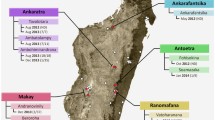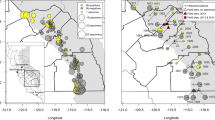Abstract
Batrachochytrium dendrobatidis (Bd) is a causal agent of disease and population decline of amphibian populations, and the extinction of several anuran species worldwide. Diverse hypotheses have been provided for the emergence of this fungus in different continents, ranging from global climate change to the vectoring of Bd via the international trade in amphibian species. In order to address these hypotheses, it is important to assess the current distribution of Bd in the context of introduced non-native amphibian species. We sampled several populations of the African clawed frog Xenopus laevis across its distribution in Chile in order to detect the presence of B. dendrobatidis and evaluate the role of this frog as a potential vector. In three of ten sites sampled, individuals harbored B. dendrobatidis infection, with an overall prevalence of infection across the studied populations of 24% (14 positive out of 58 analyzed specimens). The rapid spread exhibited by this frog within Chile suggests that transpecific transmission of the pathogen is possible, perhaps jeopardizing native species. This finding indicates the urgent need to establish long-term monitoring population programs in order to allow early detection disease-driven changes in the sizes of native populations, allowing the prompt application of conservation practices.

Similar content being viewed by others
References
ACAP (2005) Amphibian conservation summit, 17–19 September 2005. Washington, DC
Alford RA, Richards SJ (1999) Global amphibian declines: a problem in applied ecology. Annu Rev Ecol Syst 30:133–165
Berger L, Speare R, Hines HB et al (2004) Effect of season and temperature on mortality in amphibians due to chytridiomicosis. Aust Vet J 82:31–36
Blaustein AR, Romansic JM, Kiesecker JM et al (2003) Ultraviolet radiation, toxic chemicals and amphibian population declines. Divers Distrib 9:123–140
Bosch J, Martinez-Solano I (2006) Chytrid fungus infection related to unusual mortalities of Salamandra salamandra and Bufo bufo in tha Penalara Natural Park, Spain. Oryx 40:184–189
Bosch J, Martinez-Solano I, Garcia-París M (2001) Evidence of a chytrid fungus infection involved in the decline of the common midwife toad (Alytes obstetricans) in protected areas of central Spain. Biol Conserv 97:331–337
Bosch J, Carrascal LM, Durán L et al (2007) Climate change and outbreaks of amphibian chytridiomicosis in a montane area of Central Spain; is there a link? Proc R Soc Lond B Biol Sci 274:253–260
Boyle DG, Boyle DB, Olsen V et al (2004) Rapid quantitative detection of chytridiomycosis (Batrachochytrium dendrobatidis) in amphibian samples using real-time Taqman PCR assay. Dis Aquat Organ 60:133–139
Daszak P, Cunningham AA, Hyatt AD (2003) Infectious disease and amphibian population declines. Divers Distrib 9:141–150
Daszak P, Strieby A, Cunningham AA et al (2004) Experimental evidence that the bullfrog (Rana catesbeiana) is a potential carrier of chytridiomicosis, an emerging fungal disease of amphibians. Herpetol J 14:201–207
DiGiacommo RF, Koepsell TD (1986) Sampling for detection of infection or disease in animal populations. J Am Vet Med Assoc 189:22–23
Fisher MC, Garner TWJ (2007) The relationship between the emergence of Batrachochytrium dendrobatidis, the international trade in amphibians and introduced amphibian species. Fungal Biol Rev 21:2–9
Garner TWJ, Perkins MW, Govindarajulu P et al (2006) The emerging amphibian pathogen Batrachochytrium dendrobatidis globally infects introduced populations of the North American bullfrog, Rana catesbeiana. Biol Lett 2:455–459
Goldberg TL, Readel AM, Lee MH (2007) Chytrid fungus in frogs from an equatorial African montane forest in western Uganda. J Wildl Dis 43:521–524
Hanselmann R, Rodríguez A, Lampo M et al (2004) Presence of an emerging pathogen of amphibians in introduced bullfrog Rana catesbeiana in Venezuela. Biol Conserv 120:115–119
Jaksic FM (1998) Vertebrate invaders and their ecological impacts in Chile. Biodivers Conserv 7:1427–1445
Kriger KM, Hero J-M (2007) The chytrid fungus Batrachochytrium dendrobatidis is non-randomly distributed across amphibian breeding habitats. Divers Distrib 13:781–788
Laufer G, Canavero A, Núñez D et al (2007) Bullfrog (Lithobates catesbeianus) invasion in Uruguay. Biol Invasions 10:1183–1189
Lips KR, Diffendorfer J, Mendelson JR III, Sears MW (2008) Riding the wave: reconciling the roles of disease and climate change in amphibian declines. PLoS Biol 6:0441–0454
Lobos G, Garin C (2002) Xenopus laevis: behavior. Herpetol Rev 33:132
Lobos G, Jaksic FM (2005) The ongoing invasion of african clawed frogs (Xenopus laevis) in Chile: causes of concern. Biodivers Conserv 14:429–439
Lobos G, Measey J (2002) Invasive populations of Xenopus laevis (Daudin) in Chile. Herpetol J 12:163–168
Mazzoni R, Cunningham AA, Daszak P et al (2003) Emerging pathogen of wild amphibians in frogs (Rana catesbeiana) farmed for international trade. Emerg Infect Dis 9:995–998
Measey GJ (2001) Growth and ageing of Xenopus laevis in South Wales, UK. J Zool (Lond) 254:555
Mendelson JR III, Lips KR, Gagliardo RW et al (2006) Confronting amphibian declines and extinctions. Science 313:48–49
Morehouse EA, James TY, Ganley AR et al (2003) Multilocus sequence typing suggests the chytrid pathogen of amphibians is a recently emerged clone. Mol Ecol 12:395–403
Piotrowski JS, Annis SL, Longcore JE (2004) Physiology of Batrachochytrium dendrobatidis, a chytrid pathogen of amphibians. Mycologia 96:9–15
Pounds JA, Bustamante MR, Coloma LA et al (2006) Widespread amphibian extinctions from epidemic disease driven by global warming. Nature 439:161–167
Rachowics LJ, Hero J-M, Alford RA et al (2005) The novel and endemic pathogen hypotheses: competing explanations for the origin of emerging infectious diseases of wildlife. Conserv Biol 19:1441–1448
Ron SR (2005) Predicting the distribution of the amphibian pathogen Batrachochytrium dendrobatidis in the New World. Biotropica 37:209–221
Ron SR, Merino A (2000) Amphibian declines in Ecuador: overview and first report of chytridiomicosis from South America. Froglog 42:2–3
Shapiro HA, Zwarenstein H (1934) A rapid test for pregnacy on Xenopus laevis. Nature 133:762
Stuart SN, Chanson JS, Cox NA et al (2004) Status and trends of amphibian declines and extinctions worldwide. Science 306:1783–1786
Tinsley RC, McCoid MJ (1996) Feral populations of Xenopus laevis outside Africa. In: Tinsley RC, Kobel HR (eds) The biology of Xenopus. Oxford University Press, Oxford
Veloso A (2006) Batracios de las cuencas hidrográficas de Chile. In: Vila I, Veloso A, Schlatter R, Ramírez C (eds) Macrófitas y vertebrados de los sistemas límnicos de Chile. Editorial Universitaria, Santiago
Veloso A, Navarro J (1988) Lista sistemática y distribución geográfica de anfibios y reptiles de Chile. Boll Mus Reg Sci Nat Torino 6:481–539
Walker SF, Bosch J, James TY et al (2008) Invasive pathogens threaten species recovery programs. Curr Biol 18:R853–R854
Weldon C, du Preez LH, Hyatt AD et al (2004) Origin of the amphibian chytrid fungus. Emerg Infect Dis 10:2100–2105
Young BE, Lips KR, Reaser JK et al (2001) Population declines and priorities for amphibian conservation in Latin America. Conserv Biol 15:1213–1223
Acknowledgments
This research was conducted under permit of the Servicio Agrícola y Ganadero (SAG) and Corporación Nacional Forestal (CONAF) from Chile and supported by the Fundación BBVA (PI: J.B.) and the Natural Environmental Research Council, NERC, UK (PI: M.F.). We thank to Maggie Connell and two anonymous referees who contributed helpful comments that strengthened considerably the final version of the manuscript.
Author information
Authors and Affiliations
Corresponding author
Rights and permissions
About this article
Cite this article
Solís, R., Lobos, G., Walker, S.F. et al. Presence of Batrachochytrium dendrobatidis in feral populations of Xenopus laevis in Chile. Biol Invasions 12, 1641–1646 (2010). https://doi.org/10.1007/s10530-009-9577-2
Received:
Accepted:
Published:
Issue Date:
DOI: https://doi.org/10.1007/s10530-009-9577-2




